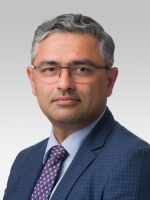The Patient is Fully Awake… As Planned
By Steve Wisel
“Did you hear about this kidney transplant in an awake patient? I didn’t know you could even do that!”
It’s rare to first hear about new developments in transplant surgery from the local news, but the excitement and press surrounding the recent awake kidney transplant performed at Northwestern University is just the kind of progress and innovation to capture the imagination of physicians and non-physicians alike.
The kidney transplant team at Northwestern led by Satish Nadig, MD, PhD and Vinayak Rohan, MD, performed their first awake kidney transplant on May 24th, 2024. Put under spinal anesthetic block, the team successfully completed the operation and safely discharged the patient on post-operative day one. Knowing that this hot topic will bring much excitement and many questions, Drs. Rohan and Nadig sat down with the Chimera to share their experience and perspectives.
 Dr. Nadig was quick to point out that this was not, in fact, the first awake kidney transplant – spinal anesthesia for kidney transplant had been used as recently as the 1970’s. However, with 2024 marking the 70th anniversary of transplantation, he felt that now was the time to “challenge the status quo – not on data, but on dogma”.
Dr. Nadig was quick to point out that this was not, in fact, the first awake kidney transplant – spinal anesthesia for kidney transplant had been used as recently as the 1970’s. However, with 2024 marking the 70th anniversary of transplantation, he felt that now was the time to “challenge the status quo – not on data, but on dogma”.
To Drs. Nadig and Rohan, this felt like a natural progression of their efforts to continue innovation in kidney transplant. Their goal is to make the recovery from kidney transplant as safe and straightforward as possible. Building on implementation of an Enhanced Recovery After Surgery (ERAS) protocol for kidney transplant and efforts to minimize opiate utilization in kidney recipients, this felt like the next natural step to hasten transplant recipients’ recovery.
“From our perspective, if we can perform C-sections under spinal, kidney transplants are much more controlled operations,” said Dr. Rohan. Put another way: “If you can give birth under spinal, you can also provide this gift of life under spinal”.
much more controlled operations,” said Dr. Rohan. Put another way: “If you can give birth under spinal, you can also provide this gift of life under spinal”.
Both doctors emphasized that initiating such a program requires much planning and collaboration. Having already developed an extensive outpatient support team to enable early discharges, they did emphasize that implementation required some logistics, including organization of teaching, medications, and follow-up for outpatient urinary catheter removal. However, with “courage and communication”, they had faith in the system around them to maintain excellent communication with patients and identify any potential problems early.
With seven cases completed and another three booked for the OR, Drs. Nadig and Rohan are already seeing the benefits of awake kidney transplant. Nearly all patients have been discharged successfully on the first post-operative day with zero opioids upon discharge. They have even played a role as Mythbusters: patients have experienced less hypotension in the OR with spinal anesthesia, allowing for straightforward post-operative recovery. Even more, despite the lack of general anesthesia and paralysis, they have found that that retraction and exposure are in fact much easier with spinal anesthesia! Patients are now reaching out to Northwestern from across the country seeking awake kidney transplant.
They emphasized that patient selection is key, and awake kidney transplant is not for everyone. In particular, well-informed and straightforward patients are a good place to start, but older patients, patients with risk for post-operative cognitive deficiencies, and patients with cardiopulmonary disease who may not otherwise be candidates stand to benefit most from this approach.
“It’s not for everyone, but certain populations may benefit,” said Dr. Nadig. “It’s part of the progression of the field, same as we have seen with bariatric surgery and hernia surgery.”
Awake kidney transplantation may revolutionize the kidney transplant experience for future patients and physicians alike. Now that it has been done successfully, surgeons can expect that patients will begin to request awake transplant. For each center, adapting existing logistics will be key to implementation. However, one logistical issue in the OR has been solved by Drs. Nadig and Rohan – what happens to music in the operating room?
With an awake patient, “the patients become their own DJs”.